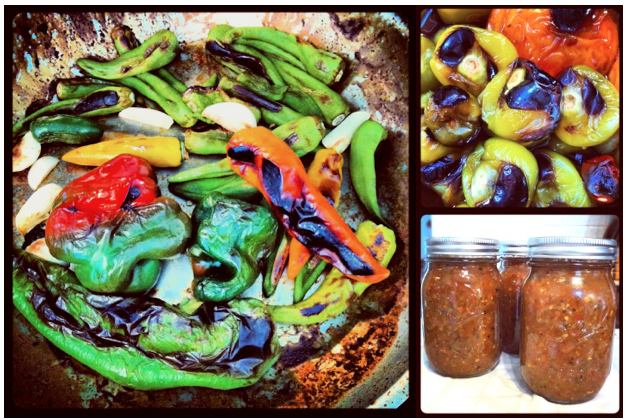
Burn baby, burn. I really enjoy canning salsa. There’s nothing better than opening a jar on a cold February day, spooning the spicy condiment onto a bean burrito or pile of scrambled eggs. That’s what canning is made for – capturing the summer’s goodness in a jar, releasing it in the chilly winter months when your brain and heart need it most. I could not survive the Minnesota winter any other way.
Hot chili peppers, sweet bells and loads of tomatoes fill my garden in August. And while I’d love to say that this batch of salsa all came from my own garden, it was really more of a community effort. I grew the sweet peppers, heirloom yellow tomatoes, garlic and white onions. My partner Chris grew the hot banana peppers and red onions. My garden neighbors Steve & Jolie grew the tomatillos, which may or may not have fallen off the vine and “rolled” into my plot. That’s just the way gardening seems to go. It all comes together one way or another, and you adapt the recipes as you go. Christmas presents of salsa are clearly spoken for…
The following recipe is an adaptation of my Salsa de Chile recipe from last summer, which follows the USDA guidelines for canning-safe salsa proportions. I’ve changed out the primary ingredients from tomatoes to tomatillos, sweet peppers to hot and retooled the spices. This is a great example of how you can build your own salsa recipe. The key thing to note is that you MUST NOT alter the proportions of tomatoes to peppers to onions to vinegar in the recipe, otherwise you risk an unsafe acid balance that is key for boiling water canning to prevent botulism. The recipe uses weight instead of volume, which will make this task much easier. Potential substitutions for tomatoes (you can use any kind of tomato as well) are tomatillos, ground cherries, peaches, plums or mangos. Any kind of pepper can be substituted for any other kind, just consider the heat, the color and the flavor you’re after. Onions, garlic, green onions and leeks are also all interchangeable as long as the total weight is the same. Vinegars may also be exchanged, so long as they are all a minimum 5% acidity. Dried spices & herbs are variable and may be increased or decrease without issue, so long as you do not use fresh varieties. And then there’s the roasting–you may roast or leave fresh any of the ingredients mentioned, but please do not leave out the simmering portion of the recipe. You may also simmer your salsa longer if you like it thicker, but add the vinegar right before you put it into the jars.
